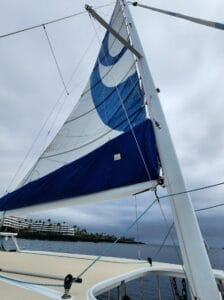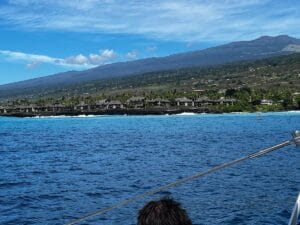The Center for Surf Reseach on how snorkeling works underwater. Join us to snorkel near the Captain Cook Monument off the beautiful Hoku Nui. This activity is a great one for snorkelers of all levels.
Basic snorkeling equipment consists of a snorkel and a mask, that allow you to see the underwater world while you float on the surface of the water without having to come up for air.
Snorkel masks cover your eyes and nose, so you can see underwater without it going up your nose. The snorkel is a flexible tube that allows you to breathe while you have your face in the water.
You hold one end in your mouth and for air exchange to happen, the top of the tube has to poke out about the water’s surface.
Next, let’s take a closer look at how snorkels work, the different types of snorkels, and other pieces of snorkeling gear you might want to consider using to maximize your snorkeling experience.
How Do You Breathe Underwater With A Snorkel?
It can take a bit of time to get used to using a snorkel. It’s best to try it in shallow waters or in the pool before going for deep water.
- Firstly ensure your mask has a good fit and adjust the strap to fit over your head. Snorkel masks should fit snugly and form a seal around your face so they don’t fill up with water or fog up.
- Next, you need to make sure your snorkel is securely attached to your snorkeling mask. Snorkels have a clip towards the mouth end or a snorkel keeper, that you can use to attach them to the mask strap.
- Once you are ready to enter the water, put the mask on and snorkel mouthpiece into your mouth. Your lips should keep the snorkel in place and also form a watertight seal around it. You can bite down gently on the mouthpiece, but take care as doing this too hard can result in jaw fatigue.
- Slowly place your face into the water making sure the top of the tube stays above the water’s surface.
- You should try to breathe slowly, taking deep breaths. This helps you to conserve energy as well as ensuring good air exchange.
- Once you’re happy with the breathing have a go at swimming around slowly, making sure you continue to take deep breaths.
What Happens If You Get Water In The Snorkeling Gear?
Unlike scuba diving where you have your own air supply, snorkels don’t let you breathe while you are fully submerged in the water.
The breathing tube can fill up if it dips below the water’s surface, for example, a wave splashing over you, or if you dive underwater to get a closer look at marine life. Sometimes snorkeling masks also get water inside or fog up making to difficult to see.
Beginner snorkelers often end up getting water in their snorkel tube or mouth so it is important to know how to get rid of it and how to clear your mask.
The first thing is not to panic, remember you are close to the water surface so you can come up for air, spitting out the snorkel, letting the water drain out, and pulling the mask off if you need to clear it.
It is possible to clear water from the snorkel tube with your face still in the water. Simply breath out sharply and this will force any water out of the tube. It’s worth practicing this technique before you go in the water.
Are All Snorkels The Same?
The answer is no, there are actually a few different types of snorkel you can choose from depending on your level of snorkeling experience.
Wet Snorkel
Wet snorkels are a J-shaped tube, also called J-style snorkels, J-tube snorkels, or classic snorkels.
Wet snorkels are suitable for experienced snorkelers and are often used by spearfishers and freedivers.
These traditional snorkels have the most basic design, with no special features to help keep the water out of the breathing tube, so aren’t a good choice if you’re a beginner snorkeler.
Semi-Dry Snorkel
The most versatile types of snorkel are semi-dry snorkels.
They offer both comfort and function, being a great choice for those who are planning on swimming underwater such as freedivers and spearfishers.
Scuba divers also use these types of snorkels for moving on the water surface to conserve their air tank supply.
Semi-dry snorkels have a splash guard at the top of the tube.
This splash guard helps keeps water out of the snorkel that could get in there from splashes from waves or other swimmers.
Semi-dry snorkels also have a purge valve. The purge valve is located at the bottom end of the snorkel letting you get rid of water in the tube really easily.
Dry Snorkel
Dry snorkels and semi-dry snorkels have the same features such as purge valves, but dry snorkels also have a float valve.
The float valve seals up the breathing tube when it is completely submerged, stopping water from getting in.
Dry snorkels are a good idea if snorkeling in waves and are perfect for beginner snorkelers.
The float valve does, however, trap the air in the tube and can create extra buoyancy and drag if diving underwater.
For this reason, dry snorkels aren’t a good option for scuba divers, freediving, or spearfishing, where you spend more time completely submerged.
What Other Snorkeling Gear Do I Need?
Although not essential you might want to consider using a snorkel vest, fins, and a wet suit.
Wetsuit
Whether you need a wetsuit generally depends on the water temperature.
Wetsuits offer varying degrees of thermal insulation.
If you are snorkeling in cooler waters they are a must so to minimize the risk of hypothermia, but even in warmer waters, wetsuits offer sun protection.
Wetsuits can also protect you from jellyfish stings, grazes from sharp rocks and coral reefs, and other marine hazards.
Fins
Fins let you glide through the water with minimal effort.
They are useful if you are a beginner as they help you conserve energy and they also allow you to stay in the water for a longer period of time without getting too tired.
Snorkeling Vest
Snorkel vests let you float and swim while keeping your face in the water. A snorkel vest is a good idea for swimmers who aren’t confident and for beginner snorkelers as they help to keep the body in the correct position for comfortable, safer snorkeling adventures.
Purchasing Your Gear
Snorkeling sets are common. They typically come with a mask and snorkel. Fins are sometimes included, but wetsuits and vests must be purchased separately.















